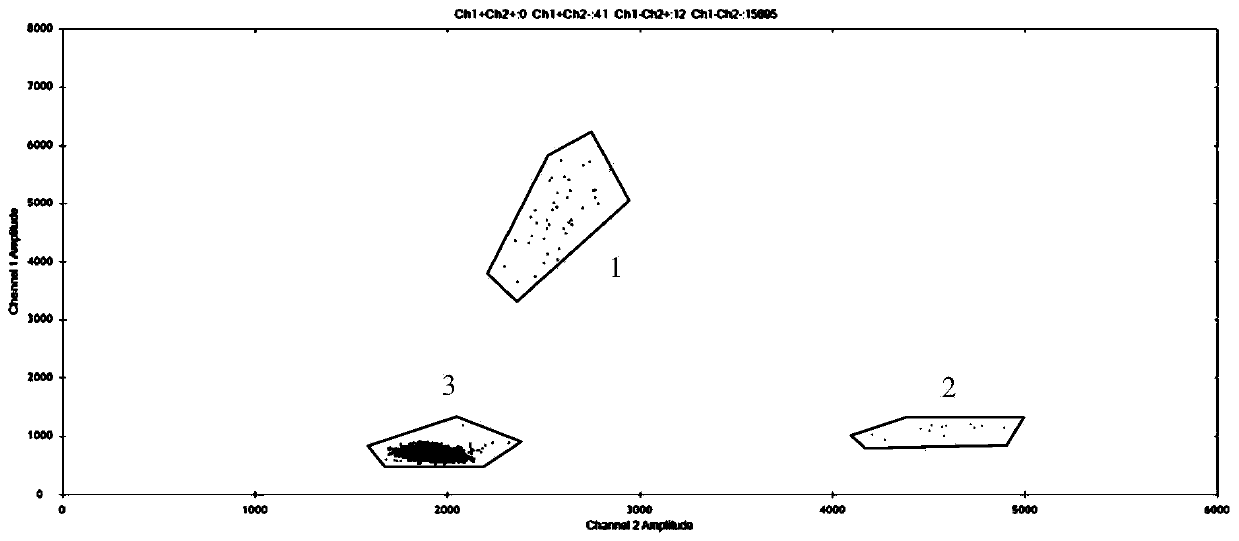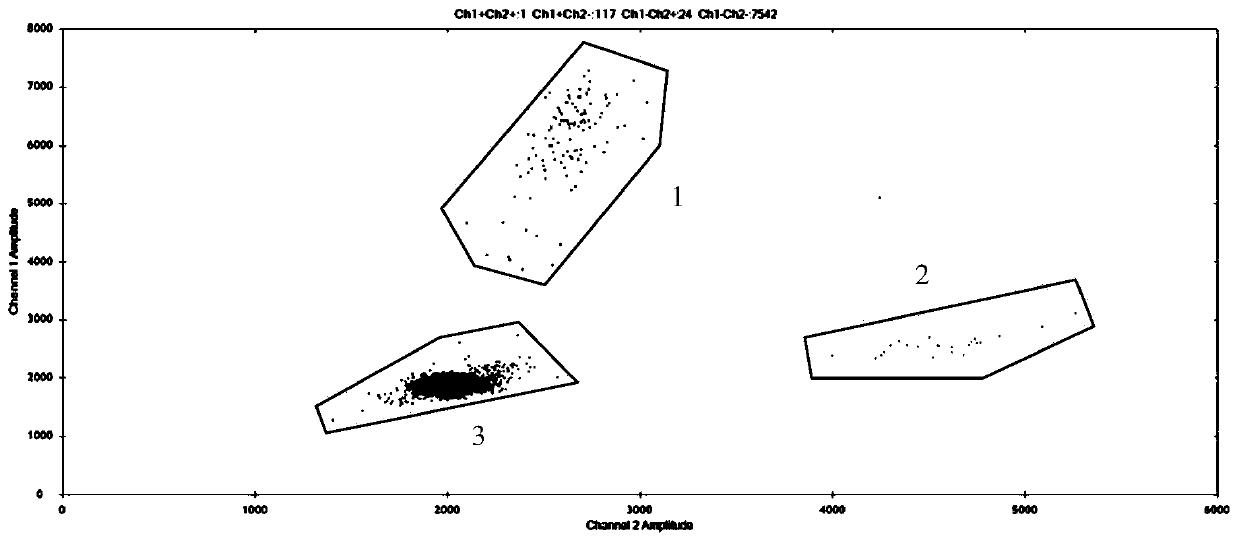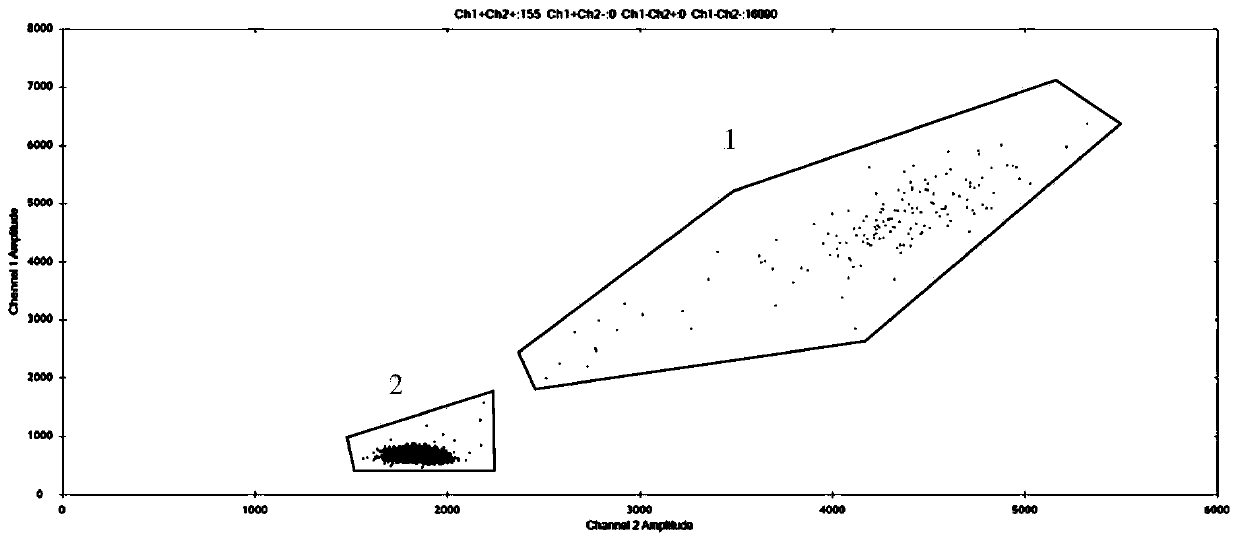Probe sets, kits, reaction systems and systems for detecting t790m and c797s cis-trans mutation types
A C797S and T790M technology, applied in the field of digital PCR, can solve the problems of inability to calculate the mutation rate, long detection cycle, high cost, etc., and achieve the effects of simplified system, low detection limit and convenient transportation
- Summary
- Abstract
- Description
- Claims
- Application Information
AI Technical Summary
Problems solved by technology
Method used
Image
Examples
Embodiment 1
[0119] Embodiment 1 probe and primer sequence design
[0120] Design probes and primers for detecting T790 and C797, among which, 6 probes are designed for C797, 1 probe is designed for T790, PCR primer pairs for amplification are designed for T790 and C797, and the number of probes and primers See Table 10 for specific sequence information, where the 5' end of the probe for C797 is marked with FAM, the 3' end is marked with a quencher group, the 5' end of the probe for T790 is marked with VIC, and the 3' end is marked with a quencher group .
[0121] Table 10 probe, primer sequence
[0122] probe name Numbering sequence C797S-0518-probe SEQ ID NO: 1 CTTCGGCTGCCTC C797S-0518-GC-probe SEQ ID NO: 2 CTTCGGCTCCCTC C797S-0518-TA-probe SEQ ID NO: 3 CTTCGGCAGCCTC ddPCR-C797S-WT-probe SEQ ID NO: 4 TTCGGCTGCCTCCTG ddPCR-C797S-TA-probe SEQ ID NO: 5 TTCGGCAGCCTCC ddPCR-C797S-GC-probe SEQ ID NO: 6 CTTCGGCTCCCTCCTG 0...
Embodiment 2
[0123] Embodiment 2 Detects the result of the selection of the probe of C797S
[0124] Use different probe combinations and concentration gradients to prepare different assay solutions, analyze the distribution of the scatter plot, and select the optimal probe and concentration:
[0125] C797S-0518-TA-probe probes use the final concentration of 0.25μM and 0.5μM, the dispersion of the scatter plot is the same, but the use of the final concentration of 0.5μM makes the fluorescence value increase (see Scatter Figure 1~4 ). Therefore, when detecting C797S (T>A), the C797S-0518-TA-probe probe (SEQ ID NO: 3) was selected, and the final concentration was selected to be 0.25 μM.
[0126] The final concentration of C797S-0518-GC-probe probe is 0.25 and 0.5μM, and the dispersion degree of the scatter plot is consistent (see Scatter Figure 5-8 ), the C797S mutation scatter point and the T790M mutation scatter point are too close, which is not conducive to the subsequent analysis of r...
Embodiment 3
[0128]This example proves that the compatibility probe can accurately reflect the copy number of the wild-type template and the copy number of the mutant template:
[0129] Use EGFR T790M assay (Reaction G) to detect normal human gDNA, H2228gDNA, HCC827gDNA, H1 975gDNA as a control, use C797S-0518-TA 0.25 assay (Reaction A) to detect normal human gDNA, H2228gDNA, HCC827gDNA, H1975gDNA as experimental group 1, use ddPCR-C797S-GC 0.25 assay (Reaction E) detected normal human gDNA, H2228 gDNA, HCC827 gDNA, H1975 gDNA as experimental group 2. Compared with the wild-type copy number of the control group, there was no significant difference in the wild-type copy number of the experimental group 1 and 2; there was no significant difference in the mutant-type copy number of the experimental group 1 and 2 compared with the wild-type copy number of the control; Probes (C797S Mu(T>A) probe and C797SMu(G>C) probe (the two probes are not mixed in the same reaction) can accurately detect bo...
PUM
 Login to View More
Login to View More Abstract
Description
Claims
Application Information
 Login to View More
Login to View More - R&D
- Intellectual Property
- Life Sciences
- Materials
- Tech Scout
- Unparalleled Data Quality
- Higher Quality Content
- 60% Fewer Hallucinations
Browse by: Latest US Patents, China's latest patents, Technical Efficacy Thesaurus, Application Domain, Technology Topic, Popular Technical Reports.
© 2025 PatSnap. All rights reserved.Legal|Privacy policy|Modern Slavery Act Transparency Statement|Sitemap|About US| Contact US: help@patsnap.com



